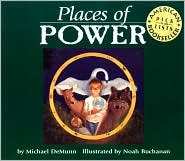Bring-a-Book: Places of Power
Janel, John, Katrina, Jess S., Lauren

Places of Power by Michael DeMunn, Illustrated by Noah Buchanan
Support Resources:
-
The Laws Guide to Nature Drawing and Journaling – written and illustrated by John Muir Laws
-
Pacific Northwest Plant Knowledge Cards – Strong Nations
-
Kidsrighttoknow.org – What is Activism?
Grade 3
Big Idea:
People from diverse cultures and societies share some common experiences and aspects of life.
Curricular Competency:
Explain why people, events, or places are significant to various individuals and groups (significance)
Begin the unit/lesson by helping students identify their own connections to places of power that they may have. Discuss and share different ideas of what each student has and a special spot they may have experienced (recognize that these may be sacred – acknowledge this and reassure kids they do not have to share the location of their secret place). Ask them if they have considered giving back to the land and environment that they are connected to. In what ways? What impact are they aiming/hoping to have?
Discussion questions:
-
What places of power for you are under environmental threat?
-
What places of power in your local district are important to the Indigenous caretakers of this land?
-
How can and to who can you advocate for places of power as a student?
Find a place of power individually, do you already have one? Where is it? Describe it, and identify what is impacting the well- being of that place. If charged with protecting this place, what would you do? Come up with a list of things you would realistically be able to do today, in the next month, in the next year, etc.
-
Have each student keep a nature journal throughout the year
-
Identify a place of power as a class. Visit it together and practice a silent moment of gratitude
-
Students can take a moment to draw, write, reflect in their journal
-
Identify what social and environmental issues impact that place
-
Identify actions that can be taken as a class to care for and protect that place
-
Create a piece of art that depicts your place of power: paint, draw, record, write a poem, etc.
-
Connect with nature by doing outdoor activities: games, gardening, walks, scavenger hunts, trash collection, sitting in nature, etc.
Potential follow up activity:
If one of the student’s places of power is under immediate threat , take action and see where it goes.
-
Address the potentiality of that action not leading to immediate change/success. How can we redefine the notion of failure? What did we learn/gain/impact through our actions? How can we “fail forward”?
Ties between ecological and climate crisis AND social justice.
-
Help students to develop empathy and understanding for how others are marginalized and may not have the same privileges we have with access to water and land. Begin the conversation of can we actually own the land? What does ownership mean and who defines that?
-
Pipeline protests show us how the climate crisis and social justice are connected (whose land is it?)
-
Have you seen/heard of/witnessed/participated in an act of climate/social justice? What was it? How did it feel?
-
Water concerns with remote Indigenous communities
-
Freedom of religion is taken away if one’s place of worship is destroyed (Whose place of worship? Where power lies is where value lies).
What can kids do? How can they intervene in the system (Meadows, Leverage Points)?
-
Write letters to their MPs
-
Advocate for change within the school
-
Talk to their parents about shopping and food options at home
-
Once you have identified your own place of power ask: what are the social issues connected to it, who “owns” it, is their interest in preserving it? what endangers it?
-
Have open discussions in class about widespread food insecurity and place that conversation in the context of your local community
-
Some small scale options- picking up trash on ocean beaches, mend your clothes workshops, classroom gardens, repurpose trash
-
Community Garden as a way of connecting to land and growing our own food, thinking of ways to collect water for the garden like using rain barrels, brainstorm with students their different ideas of fertilizer, composting, collecting leaves, learning to measure PH of the soil, buddy system with the garden plot so that this grade 3 class connects with the kindergarten class.
